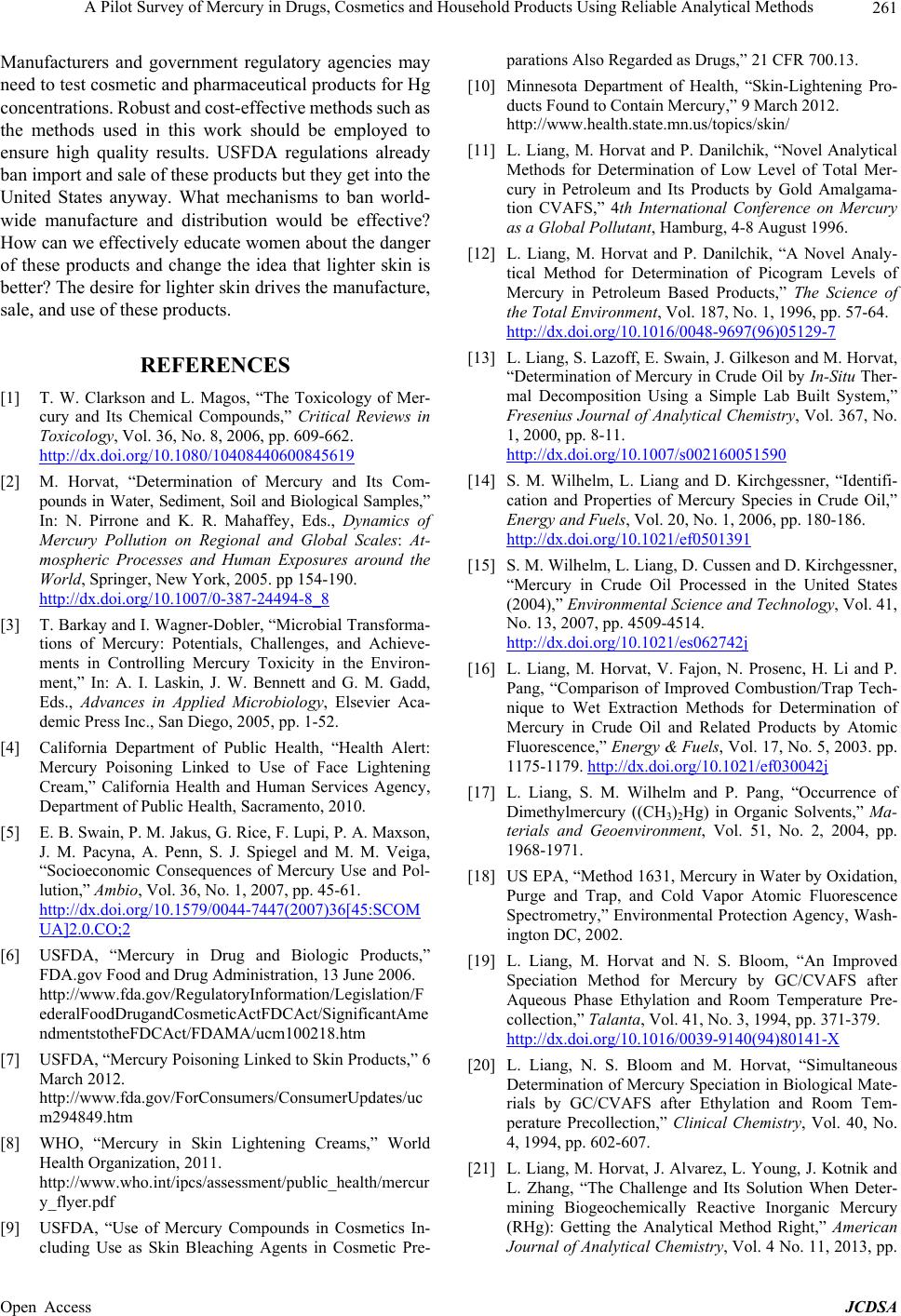
A Pilot Survey of Mercury in Drugs, Cosmetics and Household Products Using Reliable Analytical Methods 261
Manufacturers and government regulatory agencies may
need to test cosmetic and pharmaceutical products for Hg
concentrations. Robust and cost-effective methods such as
the methods used in this work should be employed to
ensure high quality results. USFDA regulations already
ban import and sale of these products but they get into the
United States anyway. What mechanisms to ban world-
wide manufacture and distribution would be effective?
How can we effectively educate women about the danger
of these products and change the idea that lighter skin is
better? The desire for lighter skin drives the manufacture,
sale, and use of these products.
REFERENCES
[1] T. W. Clarkson and L. Magos, “The Toxicology of Mer-
cury and Its Chemical Compounds,” Critical Reviews in
Toxicology, Vol. 36, No. 8, 2006, pp. 609-662.
http://dx.doi.org/10.1080/10408440600845619
[2] M. Horvat, “Determination of Mercury and Its Com-
pounds in Water, Sediment, Soil and Biological Samples,”
In: N. Pirrone and K. R. Mahaffey, Eds., Dynamics of
Mercury Pollution on Regional and Global Scales: At-
mospheric Processes and Human Exposures around the
World, Springer, New York, 2005. pp 154-190.
http://dx.doi.org/10.1007/0-387-24494-8_8
[3] T. Barkay and I. Wagner-Dobler, “Microbial Transforma-
tions of Mercury: Potentials, Challenges, and Achieve-
ments in Controlling Mercury Toxicity in the Environ-
ment,” In: A. I. Laskin, J. W. Bennett and G. M. Gadd,
Eds., Advances in Applied Microbiology, Elsevier Aca-
demic Press Inc., San Diego, 2005, pp. 1-52.
[4] California Department of Public Health, “Health Alert:
Mercury Poisoning Linked to Use of Face Lightening
Cream,” California Health and Human Services Agency,
Department of Public Health, Sacramento, 2010.
[5] E. B. Swain, P. M. Jakus, G. Rice, F. Lupi, P. A. Maxson,
J. M. Pacyna, A. Penn, S. J. Spiegel and M. M. Veiga,
“Socioeconomic Consequences of Mercury Use and Pol-
lution,” Ambio, Vol. 36, No. 1, 2007, pp. 45-61.
http://dx.doi.org/10.1579/0044-7447(2007)36[45:SCOM
UA]2.0.CO;2
[6] USFDA, “Mercury in Drug and Biologic Products,”
FDA.gov Food and Drug Administration, 13 June 2006.
http://www.fda.gov/RegulatoryInformation/Legislation/F
ederalFoodDrugandCosmeticActFDCAct/SignificantAme
ndmentstotheFDCAct/FDAMA/ucm100218.htm
[7] USFDA, “Mercury Poisoning Linked to Skin Products,” 6
March 2012.
http://www.fda.gov/ForConsumers/ConsumerUpdates/uc
m294849.htm
[8] WHO, “Mercury in Skin Lightening Creams,” World
Health Organization, 2011.
http://www.who.int/ipcs/assessment/public_health/mercur
y_flyer.pdf
[9] USFDA, “Use of Mercury Compounds in Cosmetics In-
cluding Use as Skin Bleaching Agents in Cosmetic Pre-
parations Also Regarded as Drugs,” 21 CFR 700.13.
[10] Minnesota Department of Health, “Skin-Lightening Pro-
ducts Found to Contain Mercury,” 9 March 2012.
http://www.health.state.mn.us/topics/skin/
[11] L. Liang, M. Horvat and P. Danilchik, “Novel Analytical
Methods for Determination of Low Level of Total Mer-
cury in Petroleum and Its Products by Gold Amalgama-
tion CVAFS,” 4th International Conference on Mercury
as a Global Pollutant, Hamburg, 4-8 August 1996.
[12] L. Liang, M. Horvat and P. Danilchik, “A Novel Analy-
tical Method for Determination of Picogram Levels of
Mercury in Petroleum Based Products,” The Science of
the Total Environment, Vol. 187, No. 1, 1996, pp. 57-64.
http://dx.doi.org/10.1016/0048-9697(96)05129-7
[13] L. Liang, S. Lazoff, E. Swain, J. Gilkeson and M. Horvat,
“Determination of Mercury in Crude Oil by In-Situ Ther-
mal Decomposition Using a Simple Lab Built System,”
Fresenius Journal of Analytical Chemistry, Vol. 367, No.
1, 2000, pp. 8-11.
http://dx.doi.org/10.1007/s002160051590
[14] S. M. Wilhelm, L. Liang and D. Kirchgessner, “Identifi-
cation and Properties of Mercury Species in Crude Oil,”
Energy and Fuels, Vol. 20, No. 1, 2006, pp. 180-186.
http://dx.doi.org/10.1021/ef0501391
[15] S. M. Wilhelm, L. Liang, D. Cussen and D. Kirchgessner,
“Mercury in Crude Oil Processed in the United States
(2004),” Environmental Science and Technology, Vol. 41,
No. 13, 2007, pp. 4509-4514.
http://dx.doi.org/10.1021/es062742j
[16] L. Liang, M. Horvat, V. Fajon, N. Prosenc, H. Li and P.
Pang, “Comparison of Improved Combustion/Trap Tech-
nique to Wet Extraction Methods for Determination of
Mercury in Crude Oil and Related Products by Atomic
Fluorescence,” Energy & Fuels, Vol. 17, No. 5, 2003. pp.
1175-1179. http://dx.doi.org/10.1021/ef030042j
[17] L. Liang, S. M. Wilhelm and P. Pang, “Occurrence of
Dimethylmercury ((CH3)2Hg) in Organic Solvents,” Ma-
terials and Geoenvironment, Vol. 51, No. 2, 2004, pp.
1968-1971.
[18] US EPA, “Method 1631, Mercury in Water by Oxidation,
Purge and Trap, and Cold Vapor Atomic Fluorescence
Spectrometry,” Environmental Protection Agency, Wash-
ington DC, 2002.
[19] L. Liang, M. Horvat and N. S. Bloom, “An Improved
Speciation Method for Mercury by GC/CVAFS after
Aqueous Phase Ethylation and Room Temperature Pre-
collection,” Talanta, Vol. 41, No. 3, 1994, pp. 371-379.
http://dx.doi.org/10.1016/0039-9140(94)80141-X
[20] L. Liang, N. S. Bloom and M. Horvat, “Simultaneous
Determination of Mercury Speciation in Biological Mate-
rials by GC/CVAFS after Ethylation and Room Tem-
perature Precollection,” Clinical Chemistry, Vol. 40, No.
4, 1994, pp. 602-607.
[21] L. Liang, M. Horvat, J. Alvarez, L. Young, J. Kotnik and
L. Zhang, “The Challenge and Its Solution When Deter-
mining Biogeochemically Reactive Inorganic Mercury
(RHg): Getting the Analytical Method Right,” American
Journal of Analytical Chemistry, Vol. 4 No. 11, 2013, pp.
Open Access JCDSA